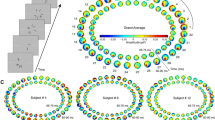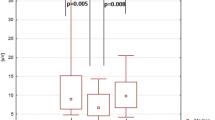Abstract
In this study we examined the effects of varying stimulus check size on multifocal visual evoked potential (VEP). We also evaluated the currently used cortical scaling of stimulus segments. The ObjectiVisionTM multifocal objective perimeter stimulates the eye with random check patterns at 56 cortically scaled segments within the visual field extending to a radius of 26°. All cortically scaled segments have equal number of checks, which gradually increase in size from the center to the periphery, proportional to the size of the segment. Stimuli with 9, 16, 25, 36 and 49 checks/segment were tested on 10 eyes belonging to 10 normal subjects. The check size varied inversely with number of checks per segment. VEP was recorded using bipolar occipital cross electrodes (7min/eye), the amplitude and latency of responses obtained were compared with the check size at different eccentricities. Our findings suggest that the existing setting with 16 checks/segment subtending 26′ to 140′ from center to periphery, is the most effective amongst all the check sizes. Decreasing the check size prolongs the latency in the central field only. Cortical scaling of segments generates responses of the same order of magnitude throughout the field, but could be improved slightly to enhance the signal from the outer two rings.
Similar content being viewed by others
References
Ristanovic D Hajdukovic R. Effects of spatially structured stimulus fields on pattern reversal visual evoked potentials. Electroencephal Clin Neurophysiol 1981; 51: 599–610.
Kurita-Tashima S et al. Effect of check size on the pattern reversal visual evoked potential. Electroencephal Clin Neurophysiol 1991; 80: 161–166.
Raniel Y et al. Miniature fiber-optic pattern-reversal stimulator for determination of the visual evoked potential threshold; comparison with snellen acuity. Graefes Arch Clin Exp Ophthalmol 1989; 227(3): 212–215.
Jenkins T, Douthwaite W. An objective VER assessment of visual acuity compared with subjective measures. Am J Optometry & Physiolog Opt 1988; 65(12): 957–961.
Ohn Y et al. Snellen visual acuity versus pattern reversal visual-evoked response acuity in clinical applications. Ophthalmic Res 1994; 26(4): 240–252.
Katsumi O et al. Effect of hemifield stimulation on simultaneous steady-state pattern reversal electroretinogram and visual evoked response. Ophthalmic Res 1993; 25: 119–127.
Katsumi O, Hirose T, Tsukada T. Effect of number of elements and size of stimulus field on recordability of pattern reversal visual evoked response. Invest Ophthalmol Vis Sci 1988; 29: 922–927.
Nakamura M et al. Effects of check size on pattern reversal visual evoked magnetic field and potential. Brain Res 2000; 872 (1–2): 77–86.
Chiappa KH, Gill EM, Lentz KE. Effect of check size on P100 latency. Electroencephal Clin Neurophysiol 1985; 61: 29–30.
Harter MR. Evoked cortical responses to checkerboard patterns: effect of check-size as a function of retinal eccentricity. Vision Res 1970; 10: 1365–1376.
Meredith JT, Celesia GG. Pattern-reversal visual evoked potentials and retinal eccentricity. Electroencephalogr Clin Neurophysiol 1982; 53(3): 243–53.
Ravamo L, Virsu V. An estimation and application of the human cortical magnification factor. Exp Brain Res 1979; 37: 495–510.
Baseler HA et al. The topography of visual evoked response properties across the visual field. Electroencephal Clin Neurophysiol 1994; 90: 65–81.
Baseler HA, Sutter EE. M and P components of the VEP and their visual field contribution. Vision Res, 1997; 37(6): 675–790.
Horton JC, Hoyt F. The representation of the visual field in the human striate cortex. Arch Ophthalmol 1991; 109: 816–824.
Klistorner A, Graham SL. Objective perimetry in glaucoma. Ophthalmology 2000; 107: 2283–2299.
Goldberg I, Graham SL, Klistorner A. Multifocal objective perimetry in the detection of glaucomatous field loss. Am J Ophthalmol 2002; 133(1): 29–39.
Klistorner AI et al. Multifocal topographic visual evoked potential: improving objective detection of local visualfield defects. Invest Ophthalmol Vis Sci 1998; 39(6): 937–950.
Sarwate and Pursley. Crosscorrelation properties of pseudorandom and related sequences. Proc IEEE 1980; 68(5): 593–619.
Klistorner A, Graham SL. Electroen ephalogram-based scaling of multifocal visual evoked potentials: Effect on intersubject amplitude variability. Invest Ophthalmol Vis Sci 2001; 42(9): 2145–2152.
Hood DC et al. An interocular comparison of the multifocal VEP: a possible technique for detecting local damage to the optic nerve. Invest Ophthalmol Vis Sci 2000; 41(6): 1580–1587.
Author information
Authors and Affiliations
Rights and permissions
About this article
Cite this article
Balachandran, C., Klistorner, A.I. & Graham, S.L. Effect of stimulus check size on multifocal visual evoked potentials. Doc Ophthalmol 106, 183–188 (2003). https://doi.org/10.1023/A:1022571530152
Issue Date:
DOI: https://doi.org/10.1023/A:1022571530152




